
The Seoul Metropolitan Subway is a metropolitan railway system consisting of 23 rapid transit, light metro, commuter rail and people mover lines located in northwest South Korea. The system serves most of the Seoul Metropolitan Area including the Incheon metropolis and satellite cities in Gyeonggi province. Some regional lines in the network stretch out beyond the Seoul Metropolitan Area to rural areas in northern Chungnam province and western Gangwon province, that lie over 100 km (62 mi) away from the capital.

The Shinbundang Line Korean: 신분당선; Hanja: 新盆唐線; literally, New Bundang Line) or DX Line for Dynamic Express Line is a 33.4 km (20.8 mi) long line of the Seoul Metropolitan Subway. It is the world's fifth subway to run completely driverless and the second completely driverless metro line to open in South Korea, after Busan Subway Line 4. It connects Sinsa station and Gwanggyo station in 42 minutes, a feat achieved by being the first line to operate South Korea's next-generation subway car travelling at over 90 km/h (56 mph), with the fastest average speed of any subway line in the country.

AREX is a South Korean airport rail link and commuter rail line that links Incheon International Airport with Seoul Station via Gimpo International Airport. The section between the two airports opened on March 23, 2007, and line was extended to Seoul Station on December 29, 2010. Long-distance Korea Train Express high speed trains started to use the line from June 30, 2014, but discontinued service in March 2018 due to low ridership.
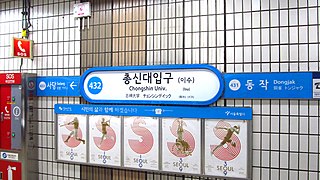
Isu Station is a subway station on the Seoul Subway Line 4 and Line 7 in Dongjak-gu, Seoul, South Korea.

Daeheung station is a subway station on Seoul Subway Line 6 in Seoul, South Korea.

Byeongjeom Station is a station on Line 1 of the Seoul Metropolitan Subway. It is the only train station serving the city of Hwaseong. It is the southern terminal station for approximately half of the subway trains on this line who then carry on to the nearby depot, one of the five depots on Line 1, with the remainder continuing to Cheonan or Sinchang Station.
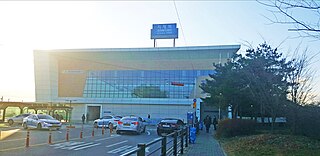
PyeongtaekJije Station is a subway station located in Pyeongtaek, South Korea. It serves the SRT and Seoul Subway Line 1. A large E-Mart store is very close to the station. On 24 November 2020, the name was changed to PyeongtaekJije.
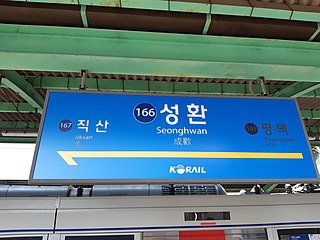
Seonghwan Station is a subway station in the province of Chungcheongnam-do. It is located north of Cheonan on the Gyeongbu Line. It is also served by services on Seoul Subway Line 1.

Achasan, also known as Rear Entrance to Seoul Children's Grand Park, is a subway station on Line 5 of the Seoul Metropolitan Subway. Located in Gwangjin-gu, in Seoul, South Korea the station is near the rear entrance of Seoul Children's Grand Park.

Cheonho station is a subway station on the Seoul Subway Line 5 and Line 8. Its station subname is Pungnaptoseong, referring to the Pungnaptoseong that runs between this station and the southeastern end of the Olympic Bridge.
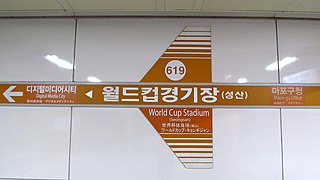
The World Cup Stadium Station is a metropolitan subway station in Seoul, Korea. The station was built to facilitate access to the Seoul World Cup Stadium for 2002 FIFA World Cup. The station has a very specific design with a main entrance reminiscent of a Greek amphitheater, between Exits 2 and 3.

Korea University Station is a subway station on the Seoul Subway Line 6. This station is located in front of the main entrance of Korea University.
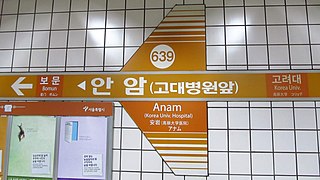
Anam station, also known as Korea University Hospital (고대병원앞) station, is a subway station on the Line 6 of the Seoul Metropolitan Subway. The station is located between the Korea University Anam Campus and the Korea University Anam Hospital.

Asan Station is a railway station on the Janghang Line which is also served by Line 1 of the Seoul Subway. Its located in Baebang-eup, Asan-si, Chungcheongnam-do, South Korea. Meanwhile, is served by all Saemaeul-ho and Mugunghwa-ho services on the Janghang Line.

Sinjeong Station is a railway station on Seoul Subway Line 5, located in Yangcheon-gu, Seoul.

Gubeundari Station is a subway station on Seoul Subway Line 5 in Gangdong-gu, Seoul.

Olympic Park is a subway station on Seoul Subway Line 5 and Seoul Subway Line 9 in Songpa-gu, Seoul. It became an interchange with Subway Line 9 on December 1, 2018.

Jeungsan Station is a railway station on Line 6 of the Seoul Subway. Its alternative name is Myongji University Station due to the proximity to Myongji University.

Sangwolgok Station is a railway station on Seoul Subway Line 6 in Seongbuk-gu, Seoul. The Korea Institute of Science and Technology is near this station.

Station numbering is a sign system which assigns station codes consisting of a few letters and numbers to train stations. It aims to facilitate navigation for foreign travelers not familiar with the local language by using globally understood characters. The system is now in use by various railway companies around the world such as in Mainland China, Indonesia, Japan, South Korea, Singapore, Taiwan, Thailand, and the United States.





















